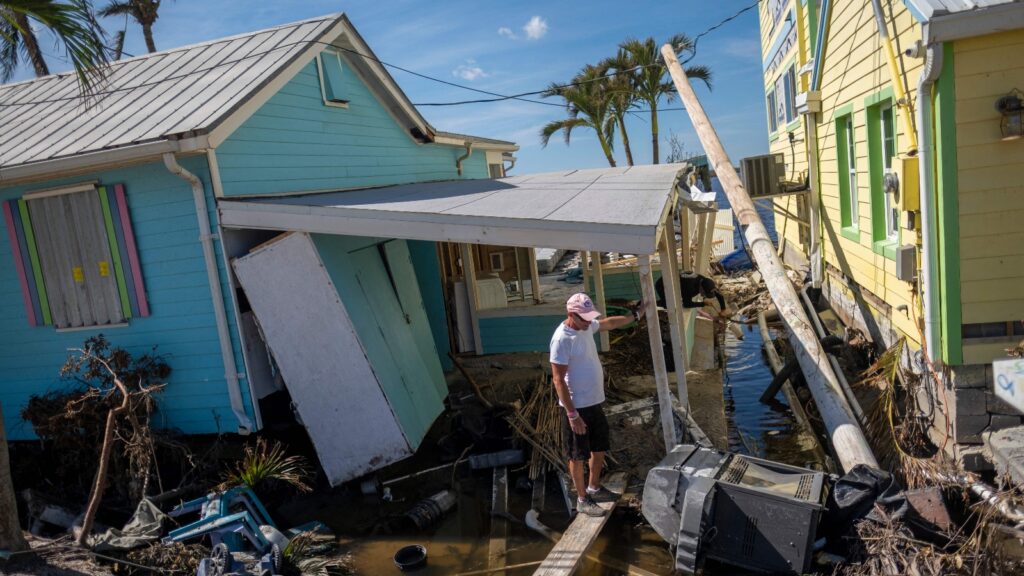The ‘hurricane tax’: How Ian is pushing Florida’s home insurance market toward collapse

When Hurricane Ian pummeled Florida last week, it left a stunning trail of physical devastation in its wake. Entire neighborhoods vanished beneath water, cities were shredded by 150-mile-per-hour winds, and thousands of people lost their homes overnight.
Though the storm has since dissipated, it will bring even more turmoil to the Sunshine State in the coming months — but this damage will be financial rather than physical. Ratings agencies and real estate companies have estimated the storm’s damages at anywhere between $30 and $60 billion, which would make it one of the largest insured loss events in U.S. history.
Wind damage is covered by standard homeowner’s insurance, and the payouts necessitated by Hurricane Ian’s extensive wreckage are likely to accelerate the collapse of the state’s homeowner’s insurance industry, driving private companies into bankruptcy and forcing thousands more Floridians into a state-run program with questionable long-term prospects. The process offers an early view of the way that natural disasters fueled by climate change threaten to upend regional economies.
Home insurance costs are poised to skyrocket for all Floridians — not just those who live in the places most vulnerable to major storms. The state will be forced to impose new taxes and penalties as it tries to keep the market afloat. New burdens will fall largely on low- and middle-income homeowners. For many working class Floridians, homeownership may become impossible to afford as a result.
“We already have a housing affordability crisis, and now we’re adding this new pressure,” said Zac Taylor, a professor at the Delft University of Technology who has studied climate risk in Florida and grew up in the city of Tampa. “Insurance is potentially the thing that is destabilizing homeownership — ironically, because it’s the thing that’s supposed to protect [homeownership] and make it possible.”
While homeowner’s insurance nationwide averages around $1500 a year, Floridians already pay almost three times as much. The state’s insurance market has been struggling ever since Hurricane Andrew made landfall south of Miami in 1992 and damaged more than 150,000 buildings. After Andrew, large private insurers like Travelers and Allstate froze their business in the state rather than risk having to pay for future disasters. This led to the creation of a public option called Citizens, which functions as an “insurer of last resort” for people who can’t find private coverage. The state also subsidized small “specialty” insurers who would only offer homeowner’s coverage in Florida, shifting market share away from national companies.
But this local market has begun to teeter in recent years, even in the absence of any major hurricanes. One reason is that Florida has become a hotbed for sham roof-repair lawsuits. Shady contractors approach a homeowner and offer her a free new roof, then file a claim with her insurer on her behalf, even if her roof didn’t actually suffer any insurable damage. Then, the contractors litigate the claim until the insurer settles. This has gotten quite expensive for insurers in the state: Florida accounted for 8 percent of all homeowner’s insurance claims in the United States in 2019, but more than 75 percent of all insurance lawsuits.
At the same time, it has become much more expensive for insurance companies to purchase their own insurance. The companies buy this so-called “reinsurance” to guarantee that they have enough money to make large payouts after big disasters, but the large global companies that sell reinsurance have gotten cagey about offering it in Florida, considering that the state has built millions of additional homes in areas vulnerable to natural disasters even as climate change increases their risk. The reinsurance companies have raised prices to account for this, and many local insurers have struggled to keep up with the costs.
The high costs of litigation and reinsurance had already driven six local insurers bankrupt so far this year, even before Hurricane Ian. In the summer, a ratings firm called Demotech threatened to downgrade several other specialty insurers, saying they weren’t stable enough to deal with a big storm. That downgrade would have made them worthless in the eyes of major lenders and effectively removed them from the market. It caused a flurry of concern from state lawmakers, one of whom said the market was about to “collapse.”
Hurricane Ian is likely to hasten that collapse by driving at least a few more homeowner’s insurance companies into bankruptcy. If Ian’s damages are close to the estimated $30 to $50 billion, it would be especially catastrophic for Florida’s already-struggling specialty insurers. The companies that do survive will have to pay even more for reinsurance, which will force them to further raise prices.
“I would predict the price of insurance will go up in Florida, or, certainly insurers will be looking for price increases,” Alice Hill, a climate change and insurance expert at the Council on Foreign Relations, told Grist. “It’s proving to be risky, particularly with climate change, looking at these storms intensifying more quickly.… Homeowner’s insurance is written on a year-by-year basis, so if a big event comes through, there’s a change next year.”
New bankruptcies and price hikes on the private market would drive thousands more Floridians to Citizens, the public insurance provider that the state established after Hurricane Andrew. The number of Floridians enrolled in Citizens has already surged over the past decade as other private insurers have collapsed, and this year the program surpassed 1 million policyholders for the first time, having doubled in size over two years. It controls around 15 percent of the insurance market — and more than twice that in especially vulnerable places like Miami.
“You’re going to see a big increase in the number of policies going to Citizens, and you could see a significant portion of the private market just go away,” said Charles Nyce, a professor of risk management at Florida State University and an expert on the state’s insurance market. “And the more of the market Citizens takes, the more at risk the state is.”
That’s because the state is on the hook to help Citizens pay out claims after big storms. Citizens has about $13 billion right now, and early estimates suggest that claims from Ian will only cost the program around $4 billion, so it’s not in any immediate financial jeopardy. But the program will balloon in size over the coming years as it absorbs all the people who lose coverage on the private market after Ian, and its expanding roster will leave it more vulnerable to the next big storm. If another Ian comes around, Citizens might find itself short on cash.
This would force Citizens to make what is called an assessment, or a “hurricane tax” in local lingo. When the program faces financial difficulties, it can impose a surcharge on every person in Florida who buys any kind of property insurance, from home insurance to auto insurance to business insurance. This surcharge acts as a kind of tax subsidy for people in vulnerable areas: Everyone in Florida ponies up to ensure the state can help storm victims rebuild.
“That’s the biggest concern I have,” said Nyce. “Say you’re a single mom working in Orlando living in an apartment, but yet you have to own a car. Now you’re paying an assessment on your auto insurance to subsidize someone who lives on the beach.”
Since Hurricane Ian is unlikely to stem the tide of new arrivals to Florida — and since the only insurance option for these new arrivals will be Citizens — Nyce said that these assessments could become much more common as the years go on. In the past they have never exceeded around 1.5 percent of annual insurance bills, but future storms could drive that number higher.
Citizens can also issue bonds to fund payouts, said Nyce. But because it would issue those bonds against the state’s credit rating, doing so could dampen the state’s own ability to borrow money, again leading to higher costs down the road. And the more tax revenue the state spends propping up Citizens, the less it has to fund other essential services like education and transportation.
The upshot is that Hurricane Ian could make life in Florida a lot more expensive for everyone in the state who owns a home or a car. Decades of rapid development and a new era of supercharged storms have created a risk burden that is impossible for the private insurance market to bear. Now, in the aftermath of Ian, the state’s 21 million residents will assume more and more of that risk, and their wallets will see its earliest effects.
For an example of how these costs might impact vulnerable Floridians, Taylor pointed to the community of Miami Gardens, a majority-Black community in the Miami metroplex that is one of the last places in the region where homes are affordable.
“How is this community supposed to reduce its risk?” they said. “How are homeowners going to deal with this? We’re talking potentially the equivalent of multiple monthly mortgage payments … and this is not poised to go [back] down. Fewer and fewer people are going to be able to afford their houses.”
This story was originally published by Grist with the headline The ‘hurricane tax’: How Ian is pushing Florida’s home insurance market toward collapse on Oct 5, 2022.
This content was originally published here.




Responses